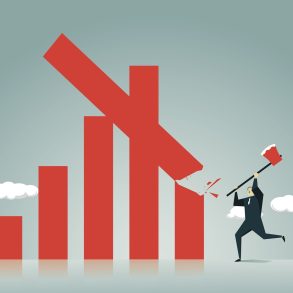“I think this is the real thing. This is the end of extremely low interest rates. They’re simply unsustainable.” – Economist Benjamin Tal, August 2013
 Benny Tal is one of the sharpest economic analysts on the block. For him to go out on a limb like this shows how convincing the rate-hike thesis was last summer.
Benny Tal is one of the sharpest economic analysts on the block. For him to go out on a limb like this shows how convincing the rate-hike thesis was last summer.
Since that time, the unsustainable has proven quite sustainable.
Following the spring/summer rate spikes of 2013, homeowners feared that the low-rate ship had sailed. And now, only 6 to 7 months later, the market is again flush with sub-3% mortgages.
Just yesterday, in fact, Scotiabank launched the lowest mass-market 5-year fixed rate in its history: 2.97%. (Mind you, this is a rate the bank could have marketed last year, had the previous Finance Minister – with all due respect – not suppressed rate competition.)
Of course, Scotia’s offer trails credit unions and brokers, who have already been quoting 5-year rates in the 2% range for most of this year.
And then we have Investors Group’s prime – 1.01% variable, which is easily the rate of the year thus far.
The point is, despite what credible commentators may forecast, and despite how hawkish the economic data may get, rates may go up but they don’t have to stay up.
Each day that passes, the market gets slightly more comfortable with the notion that low rates are a long-term phenomenon, due in large part to demographics and structural economic changes. Former Fed chief Ben Bernanke reportedly opined in private recently that the Fed Funds rate (one of the most influential interest rates in the world) would not return to its long term average in his lifetime.
 Economic analysts are now acknowledging the possibility of a neutral Bank of Canada rate that’s just 1 percentage point above today’s 1.00%. Talk like that would have been considered heresy at the turn of this century.
Economic analysts are now acknowledging the possibility of a neutral Bank of Canada rate that’s just 1 percentage point above today’s 1.00%. Talk like that would have been considered heresy at the turn of this century.
The above is all educated speculation of course, but it’s something to consider after you’ve assessed all other term selection criteria. Those being:
- Your tolerance for higher rates (and the potential for a 25-35% jump in your payments and/or interest cost).
- The premiums being charged for rate certainty – i.e., how much more you’ll pay for longer fixed-rate terms.
- The probability of you refinancing or moving before your mortgage term is up.
- The proven tendency of short-term rates to outperform long term rates.
- Your ability to qualify in the future based on your employment situation, marital status, rental property holdings, etc.
- The benefit of diversifying your rate exposure (e.g., choosing a hybrid mortgage, or choosing a fixed mortgage if you’ve already got heavy exposure to long-duration fixed income investments.)
- And so on…
If your plan incorporates these factors and today’s rates truly are unsustainable, at least you’ll be able to ride out the increase with confidence.
And if rates continue at these “unsustainable” levels, borrowers should consider it a gift…one that hopefully keeps on giving.
Rob McLister, CMT (email)







Here’s some advice. Do the opposite of what economists tell you. You’ll only be wrong half the time.
Keep the rates low, tighten the lending criteria and we’ll be just fine.
Must be faaaaaaaaaantaaaaaastic to get paid in spite of being wrong – consistently. How many jobs do we know of where one can get away with that?
“Analysts”? Screw you…
You mean tighten lending criteria further?
How, and perhaps more importantly why?
“I find it objectionable that economists can’t accurately predict the future” – Olly and Michael, apparently
You will find out very soon. CMHC has already announced there are more changes coming
Why do we currently have low interest rates in comparison to historical norms?
Because inflation and economic growth are low compared to historical norms.
And do you agree that at some point the economy will improve, causing interest rates to increase? I tell colleagues that low interest rates aren’t the norm and I’m called a doomer. The irony is that if you think low interest rates are here to stay, you’re actually the doomer!!
Rates have to increase. Then they have to drop again. That’s about all anyone can say.
Oh no, that sounds so vague and yet somehow ominous. Do you know Garth Turner? Time to crawl back into the basement and close the door behind you.